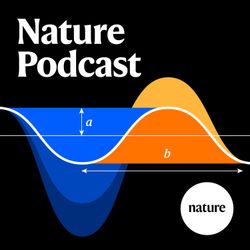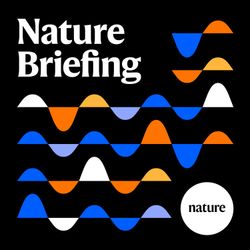Latest episode

The biggest 'Schrödinger's cat' yet — physicists put 7,000 atoms in superposition
26:32|00:46 Protein-sized superposition surpasses previous experimentsNature: Pedalino et al.News: Schrödinger's cat just got bigger: quantum physicists create largest ever 'superposition'11:46 Research HighlightsNature: Ancient pottery reveals early evidence of mathematical thinkingNature: Gifted dogs learn new words by overhearing humans14:11 How Trump’s second term has impacted researchNature: US science after a year of TrumpNature: US science in 2026: five themes that will dominate Trump’s second year
More episodes
View all episodes

Briefing Chat: Can NASA return rocks from Mars? And why dogs have long ears
10:04|In this episode:00:40 The rock samples destined to remain on MarsNature: NASA won’t bring Mars samples back to Earth: this is the science that will be lost05:24 The genetics of dogs’ droopy earsNature: Do their ears hang low? The genetics of dogs’ adorable floppy earsSubscribe to Nature Briefing, an unmissable daily round-up of science news, opinion and analysis free in your inbox every weekday.
AI can turbocharge scientists' careers — but limit their scope
21:38|In this episode:00:47 AI can boost research productivity — at what cost?Research article: Hao et al.10:10 Research HighlightsNature: Ancient ‘snowball’ Earth had frigidly briny seasNature: Putting immune cells into ‘night mode’ reduces heart-attack damage12:41 JWST images are full of red dots, what are they?Nature: Rusakov et al.Subscribe to Nature Briefing, an unmissable daily round-up of science news, opinion and analysis free in your inbox every weekday.
A mysterious ancient fingerprint and a lemon-shaped planet — the stories you’ve missed
16:32|00:54 Turning an undersea cable into a seismic detectorResearchers have shown that they can piggyback a signal on a 4,400-kilometer-long telecom cable that runs from California to Hawaii, allowing it to act like 44,000 separate seismic-activity detectors. Their method takes advantage of impurities found in glass fibre-optic cables, which reflect light differently when they are stretched and distorted by the pressure of seismic waves.Science: Seafloor telecom cable transformed into giant earthquake detector04:17 The origin of an ancient boatChemical analysis of the caulking found on the wood an ancient boat has helped researchers identify the origins of the vessel, that sank off the coast of Denmark 2,400 years ago. The team’s analysis suggests it voyaged from much farther away that had been thought — perhaps coming from the Baltic Sea region. The team also found a fingerprint left in the caulk, although who it belonged to is unknown.LiveScience: Fingerprint of ancient seaborne raider found on Scandinavia's oldest plank boat08:29 How heating up helps some plants pollinateSome plants called cycads (Zamia spp.) heat up to attract the beetles that pollinate them. These beetles have heat-seeking sensors in their antennae, which they use locate the plants. Male cycads warm up around 3 hours before females, meaning that beetles head to them before first carrying pollen over to the females.Science: Heat-seeking beetles drawn to plants that glow in infrared13:08 The exoplanet shaped like a lemonThe discovery of exoplanet PSR J2322-2650b reveals how unusual other worlds can be. This exoplanet takes just 7.8 hours to orbit an ultra-dense pulsar whose intense gravity pulls PSR J2322-2650b into a lemon shape.New Scientist: Strange lemon-shaped exoplanet defies the rules of planet formationSubscribe to Nature Briefing, an unmissable daily round-up of science news, opinion and analysis free in your inbox every weekday.
Science in 2026: what to expect this year
11:53|In this episode, reporter Miryam Naddaf joins us to talk about the big science events to look out for in 2026. We’ll hear about: small-scale AI models that could outcompete Large Language Models in reasoning, clinical trials of gene editing to treat rare human disorders, a sample collection mission from Phobos, and how changes to US policy by the Trump team are expected to impact science.Subscribe to Nature Briefing, an unmissable daily round-up of science news, opinion and analysis free in your inbox every weekday.
Audio long read: Will blockbuster obesity drugs revolutionize addiction treatment?
17:54|Anecdotal stories suggesting that weight-loss drugs can help people shake long-standing addictions have been spreading fast in the past few years, through online forums, weight-loss clinics and news headlines. And now, clinical data are starting to back them up.Over a dozen randomized clinical studies testing whether GLP-1 drugs like Ozempic can suppress addiction are now under way, and neuroscientists are working out how these weight-loss drugs act on brain regions that control craving, reward and motivation.Scientists warn that the research is still in its early stages, but some researchers and physicians are excited, as no truly new class of addiction medicine has won approval from regulators in decades.This is an audio version of our Feature: Will blockbuster obesity drugs revolutionize addiction treatment?
The Nature Podcast highlights of 2025
40:09|00:40 What a trove of potato genomes reveals about the humble spudResearchers have created a ‘pangenome’ containing the genomes of multiple potato types, something they believe can help make it easier to breed and sequence new varieties. The potato’s complicated genetics has made it difficult to sequence the plant’s genome, but improvements in technology have allowed the team to combine sequences, allowing them to look for subtle differences in between varieties.Nature Podcast: 16 April 2025Research Article: Sun et al.10:28 Hundreds of physicists on a remote island: we visit the ultimate quantum partyAccording to legend, physicist Werner Heisenberg formulated the mathematics behind quantum mechanics in 1925 while on a restorative trip to the remote North Sea island of Heligoland.To celebrate the centenary of this event, several hundred researchers have descended on the island to take part in a conference on all things quantum physics. Nature reporter Lizzie Gibney was also in attendance, and joined us to give an inside track on the meeting.Nature Podcast: 13 June 202519:54 Research HighlightsA minuscule robot that can manipulate liquid droplets, and the discovery of ancient puppets on the remains of a large pyramid offers a glimpse into rituals in Mesoamerica.Research Highlight: This tiny robot moves mini-droplets with easeResearch Highlight: Ancient puppets that smile or scowl hint at shared rituals23:03 These malaria drugs treat the mosquitoes — not the peopleResearchers have developed two compounds that can kill malaria-causing parasites within mosquitoes, an approach they hope could help reduce transmission of the disease. The team showed that these compounds can be embedded into the plastics used to make bed nets, providing an alternative to insecticide-based malaria-control measures, which are losing efficacy in the face of increased resistance.Nature Podcast: 21 May 2025Research article: Probst et al.33:49 Briefing ChatThe first skeletal evidence that Roman gladiators fought lions.BBC News: Bites on gladiator bones prove combat with lionSubscribe to Nature Briefing, an unmissable daily round-up of science news, opinion and analysis free in your inbox every weekday.